Carrots are a widely cultivated root vegetable, belonging to the Apiaceae family. They are usually orange in color, although they can also come in purple, white, yellow, and black varieties. They are native to Europe and Southwestern Asia.
The cultivation of carrots has a long history, with evidence of their domestication in Central Asia around 1000 CE. Wild carrot, known as Queen Anne’s lace, is native to Eurasia and was likely the ancestor of the modern, domesticated carrot. Carrots were cultivated in China and Europe by the 13th century and were later distributed to United States during European colonization.
Carrots are biennial plants with a taproot that can be globular or long in shape. The taproot is the edible part of the plant, which stores nutrients to support the growth of the plant in its second year when it flowers. The flowers are small and white or pinkish, borne on large compound clusters (umbels) at the ends of the main stalk and branches.
Growing carrots requires cool to moderate temperatures and is not recommended in regions with hot summers. If left unharvested, the plant will survive through the winter and produce large flower stalks in the following growing season. Carrots can be grown in many soils but prefer deep, well-drained sandy or loamy soils with a pH range of 6.0 to 6.8.
Carrots can withstand the first light frost, and it may even help them taste sweeter, but they should be harvested before a hard frost. The variety of carrots you plant will also determine when it is the best time to harvest your crop.
Carrots can be prepared in many ways, including being eaten raw, roasted, boiled, steamed, grilled, and even juiced. They are rich in beta-carotene, which the body converts into vitamin A, and they are a good source of fiber, vitamin K, and potassium.
Carrots pair well with almonds, bacon, butter, celery, cheeses such as cheddar, parmesan and pecorino, cinnamon, cream, ginger, parsley, potatoes, mushrooms, shallots, tomatoes, and red or white wine vinegar.
List of Different Varieties of Carrots
- Nantes
- Danvers
- Imperator
- Chantenay
- Kuroda
- Pusa Meenakshi carrots
- Flakee
- Cosmic Purple
- Purple Haze
- Dragon
- Atomic Red
- Black Knight carrots
- White Bunched Carrots
- White Satin Carrots
- Parisian
- Thumbelina
- Amarillo
- Red Samurai
- Jaune Obtuse du Doubs
- Bolero
- Napoli
- Sugarsnax
- Autumn King
- Little Finger
- Scarlet Nantes
- Touchon
- Yaya carrots
- Mokum carottes
- Lunar White
- Royal Chantenay
- Berlicum
- Kyoto Red
- Amstal
- Bolgheri
Description And Pictures
Nantes

Nantes carrots are a type of carrot that originated in the city of Nantes, France, and were developed by the Vilmorin-Andrieux seed company in the 1850s. They are fast to mature, reaching full growth in 65 to 75 days, earning them the nickname “Early Coreless.”
- Size and Shape: Short and cylindrical, typically 6-8 inches long with a blunt or pointed tip
- Color: Bright orange
- Flavor: Sweet and crisp
- Maturity: 60-70 days
- Soil Tolerance: More tolerant of heavier soils than some other carrot varieties
Danvers carrots

Danvers carrots are a variety of carrot developed in the late 19th century in Danvers, Massachusetts. They usually have sweet flavor, firm and crunchy texture, and uniform shape.
Two Popular Varieties:
- Danvers Half-Long: Has a blunt tip and broad shoulders that taper to a point.
- Danvers Full-Long: These carrots grow longer than their half-longs. They maintain the same broad shoulders and tapered point.
Characteristics
- Size and Shape: Danvers Half-Long (6-8 inches), Danvers Full-Long (up to 10 inches), both with broad shoulders tapering to a point.
- Color: Deep orange
- Flavor: Sweet and flavorful, especially when young. Mature roots can become slightly fibrous.
- Maturity: 65-85 days
- Soil Tolerance: Performs well in various soil types, including heavier soils
Imperator carrots
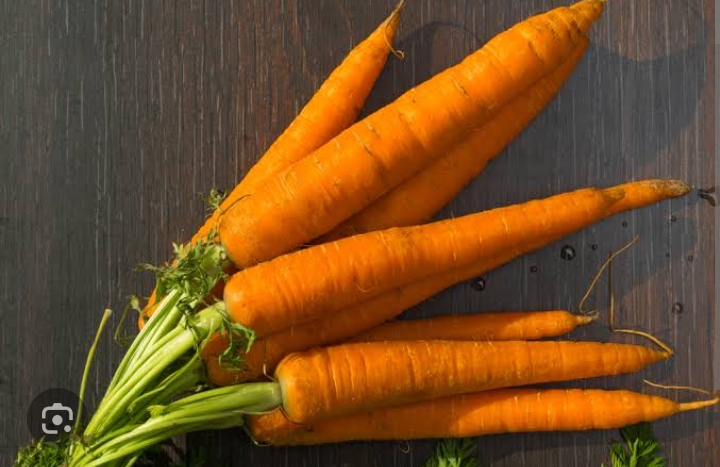
They were developed in 1928 by Associated Seed Growers as a stabilized cross between ‘Nantes’ and ‘Chantenay’ carrots. They grow to be about six to seven inches long, although baby varieties can be just a few inches long. They have a deep, rich orange hue and a faintly notched, knobby build.
Characteristics
- Appearance: Long and slender, typically reaching 8-10 inches in length with a pointed tip and smooth, straight sides.
- Color: Deep, vibrant orange throughout the entire root.
- Flavor: Sweet and crisp.
- Maturity: Takes around 70-80 days to reach maturity.
- Storage: Imperator carrots store well due to their lower sugar content compared to some other varieties.
Chantenay carrots
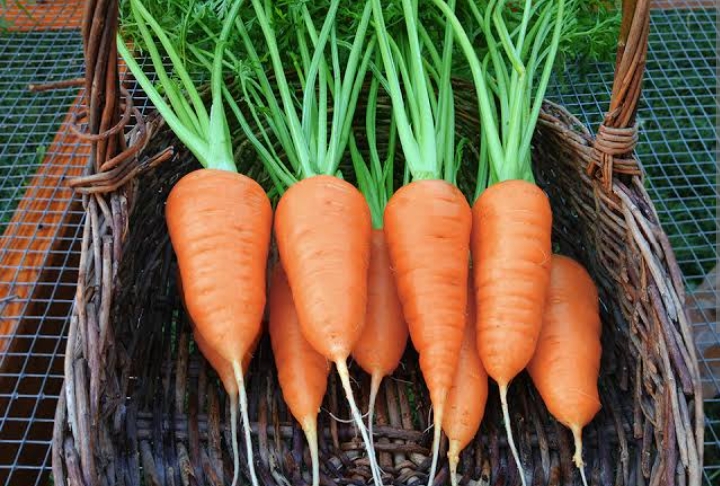
They were developed during the 18th century in the Chantenay region of France and were first introduced in the seed catalog of Vilmorin Andrieus. These carrots are shorter and broader in shape compared to traditional long carrots, with a conical shape and a rounded tip.
Characteristics:
- Appearance: Short and stubby, reaching 4-6 inches in length.
- Flavor: Sweet and flavorful, with a good balance between sugars and starches.
- Maturity: Relatively fast-growing, maturing in about 60-70 days.
Popular Chantenay Varieties
- Red Chantenay: Features a vibrant red exterior with a classic Chantenay shape and flavor profile.
- Royal Chantenay: This is a longer version of the classic Chantenay.
Kuroda carrots

Kuroda carrots are a heirloom variety that grow well in hot and humid climates. They were originally developed in Japan during the 1950s and have been improved upon over the years to become one of the best-tasting carrot varieties available.
Characteristics
- Appearance: Short and stocky, reaching 5-7 inches in length with a blunt tip and broad shoulders.
- Flavor: Sweet and earthy.
- Maturity: Relatively fast-growing, maturing in about 70-80 days.
Pusa Meenakshi carrots

Pusa Meenakshi carrots are a type of Indian carrot. They are usually long, slender shape and deep red color. They are a popular for growers in India because of their high carotene content and good yield.
Characteristics
- Appearance: Long and slender, reaching 8-10 inches in length with a pointed tip and smooth sides.
- Color: Deep red throughout the entire root.
- Flavor: Sweet and slightly earthy, with a good balance of sugars and starches.
- Maturity: Takes around 70-80 days to reach maturity.
Flakee Carrots

“Flakee” carrots or “Carrot Flakkee.” aren’t actually a specific variety of carrot, but rather a term used by some seed companies to describe a particular type of carrot seed or the resulting carrot grown from those seeds.
Some seed companies may use the term “Flakkee” to refer to larger, pelleted carrot seeds. These pelleted seeds are easier to handle and sow, especially for those with limited dexterity or when planting in windy conditions. The “Flakee” designation likely refers to the flattened or flake-like shape of these pelleted seeds.
Characteristics
- Large size: These carrots can grow up to 8-9 inches long and over 2 inches in diameter at the shoulder.
- Heavy yield: They produce a large quantity of carrots per planting.
- Good flavor: They have a sweet taste and good eating quality.
- Tolerance to diseases: This variety is said to have some resistance to leaf blight.
Purple Cosmic carrots

These elongated, pigmented roots were created in the United States in 2005 and are descendants of the original purple carrot varieties native to Central Asia. Purple Cosmic carrots are considered a modern variety with improved flavors.
Characteristics
- Appearance: Deep purple exterior with a bright orange core.
- Flavor: Slightly sweet and nutty flavor, with a hint of earthiness.
- Maturity: Takes around 70-75 days to mature.
Purple Haze Carrot

Purple carrots originated over five thousand years ago in present-day Afghanistan in Central Asia. Considered to be one of the original carrots to be domesticated, many natural hybrids and mutants were developed and crossed with wild and cultivated varieties creating new cultivars varying in core color, size, and flavor.
Characteristics
- Appearance: Similar to Cosmic Purple carrots, Purple Haze carrots have a deep purple exterior with a bright orange core.
- Flavor: These carrots are known for their sweetness and have a slightly spicy kick.
- Maturity: Matures in about 90 days.
Cosmic vs Purple Haze Carrots
| Feature | Cosmic Purple | Purple Haze |
|---|---|---|
| Maturity | 70-75 days | 90 days |
| Flavor Profile | Slightly sweet, nutty | Sweet with a spicy kick |
| Ease of Growing | Moderate | Easy |
Dragon carrots
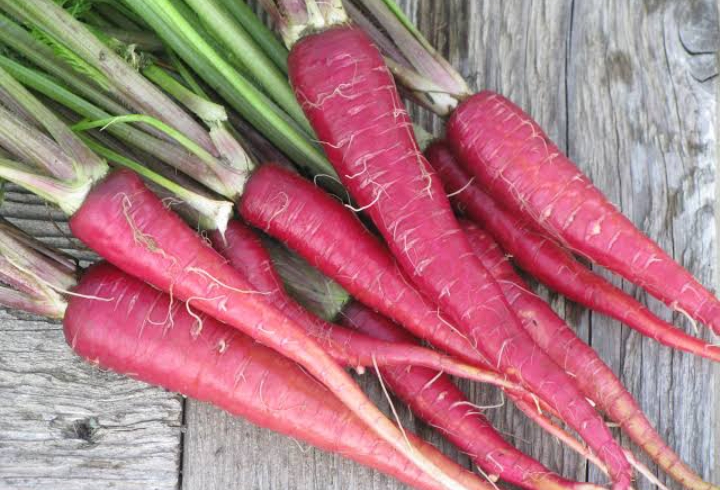
Dragon carrots were created by breeder Dr. John Navazio and were developed from an unknown USDA specimen. Believed to be a descendant of the danvers carrot, Dragon carrots are still considered somewhat rare as they are not commercially cultivated and were selected as a specialty cultivar to promote diversity among home gardeners and farmer’s markets. They can be grated or shredded and used in salads or slaws, where their flavors and colors can shine.
Characteristics
- Appearance: The skin is semi-smooth, lightly ridged, and has a variegated red-purple hue. Underneath the surface, the flesh is crunchy, dense, and bright orange.
- Maturity: The carrots take around 75-80 days to reach maturity.
- Flavor: Spicy kick.
Atomic Red carrots
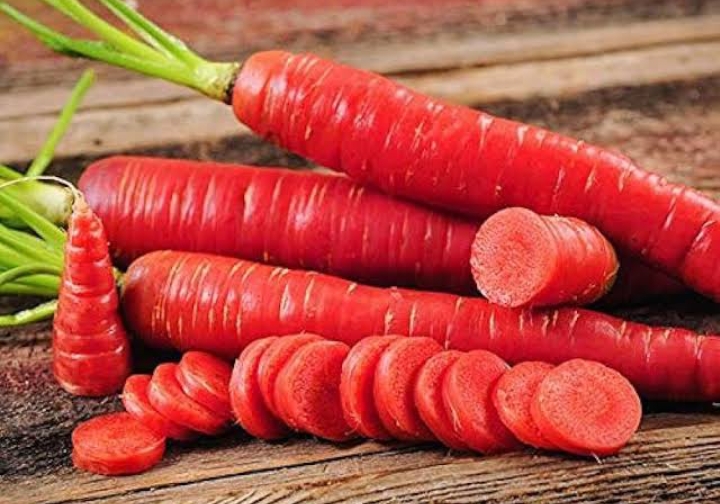
Atomic Red carrots are unique variety of carrots with coral-red to scarlet exterior skin color. Harvesting Atomic Red carrots usually takes about 75-90 days after sowing, and they are best harvested when the roots are about 6-8 inches long. The inner flesh has a contrasting orange core, while others may have a more uniform reddish-orange color throughout.
Characteristics
- Flavor: Sweet and Crisp
- Relatively Fast Growers: Atomic Red carrots typically mature in 65-70 days.
- Use: They can be grated or shredded and used in salads or slaws, where their colors and flavors can shine.
While Atomic Red carrots can tolerate warmer weather, they may perform best in cooler conditions. If you have hot summers, consider planting them in a location with some afternoon shade.
Black Knight carrots
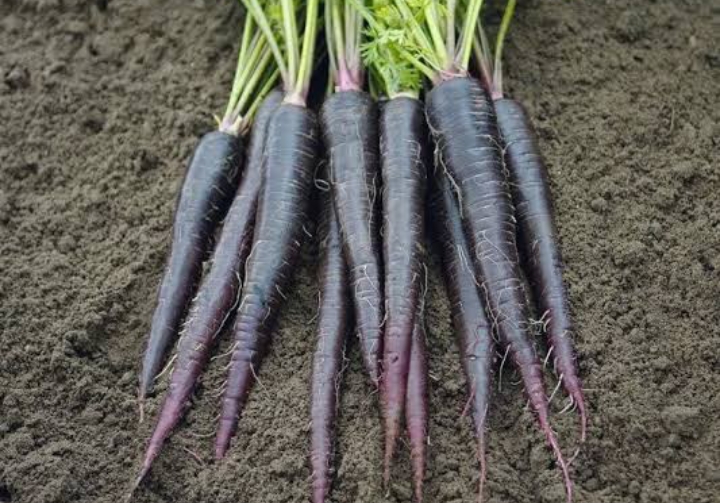
Black Knight carrots are a descendant of the Eastern wild carrot, a purple-rooted carrot native to Afghanistan in the region where the Himalayan and Hindu Kush mountains meet. As the roots were domesticated, natural hybrids and mutants were developed and crossed with wild and cultivated varieties creating new cultivars varying in color, size, and flavor.
Characteristics
- Exterior: A deep, inky purple that almost appears black
- Interior: Yellow or orange
- Flavor: Mild and Slightly Sweet
- Maturity: Takes around 85 days to reach maturity.
Black Nebula carrots

Black Nebula carrots were created by Seeds by Design, a seed company based in Maxwell, California, and were released through online catalogs in 2016. Today Black Nebula carrots are a rare variety that is still found through online seed catalogs. They are sown in early spring, once the soil has warmed up, and take about 10-14 days to germinate. They are ready to harvest within 70 to 80 days.
Characteristics
- Exterior: A deep purple-black color
- Interior: A dark purple with streaks or swirls of orange
- Flavor: Sweet and Earthy
- Maturity: Takes around 75 days to reach maturity
White Bunched Carrots

White carrots were believed to be first domesticated in the Mediterranean region in the 8th century. The first illustration of a White carrot, labeled No 23 Karettes Daucus Carota, was featured in an Italian Herbal catalog in 1500 CE. White bunched carrots, also sometimes called White Satin carrot can be found in the United States, Europe, and Asia.
Characteristics
- Size and Shape: They are small and slender and have a roughly cylindrical shape with a tapered and thin tip.
- Color: Pale yellow to white skin
- Flavor: Milder and sweeter flavor
- Maturity: Within 60-70 days of planting.
Yellow Bunched Carrots

Yellow carrots originated over five thousand years ago in present-day Afghanistan in Central Asia.Yellow Bunched Carrots also referred to as Yellowstone carrots. Yellow bunched carrots are small and have a slender, conical shape with a tapered tip.
Characteristics
- Color: Light yellow to gold color
- Sold Bunched: These carrots are often sold with their fresh green tops still attached
- Flavor: Sweet and mild flavor profile
- Maturity: Within 50-60 days of planting.
White Satin Carrots
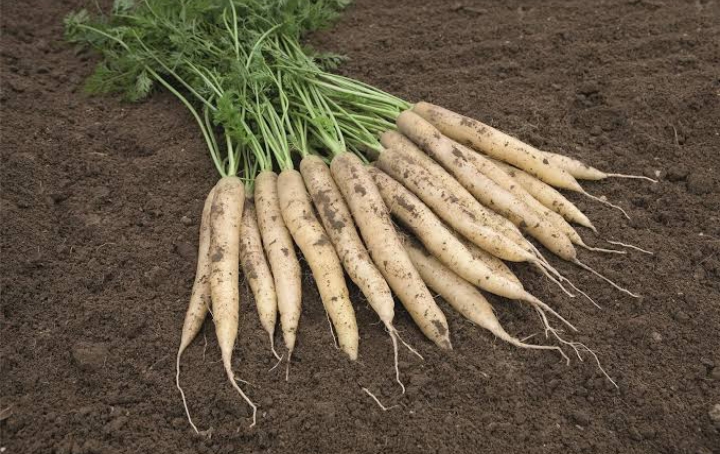
White Satin carrots were developed in California United States. They are small and slender, averaging around 7-10 centimeters (3-4 inches) in length. They have a roughly cylindrical shape with a tapered and thin tip. These carrots are a testament to the rich history and evolution of carrot cultivation.
Characteristics
- Color: Pale yellow to white skin
- Flavor: Milder and sweeter flavor compared to orange varieties.
- Maturity: Mature quickly, typically within 60-70 days of planting.
- Planting Time: Similar to most carrots, sow seeds in early spring or fall in most climates.
Parisian Carrots

Parisian carrots are a type of round carrot and are also known as Parisian Market carrots, Parisian Rondo, Paris Market carrots, Parisienne carrots, and Tonda Di Parigi, which translates from Italian to mean the “round of Paris.” Parisian carrots were developed in France sometime during the 1800s. Today, they are found throughout Europe, Asia, Australia, Africa and the United States. Parisian carrots are quite small, measuring only 2 to 5 centimeters (around 1-2 inches) in diameter.
Characteristics
- Size and Shape: They have a round, almost radish-like shape, with a single elongated taproot
- Color: Bright orange skin, similar to classic orange carrots.
- Flavor: Sweet with earthly notes
- Maturity: Maturing in just around 60 days from planting
Thumbelina carrots

The Thumbelina carrot is a round, gourmet carrot variety. They are on the smaller side, maturing to a golf ball size (around 2-inches in diameter) and a round or globe-shaped form. They are relatively fast growers, maturing in around 60-70 days from planting.
They are ideal for short growing seasons or for planting successions throughout the summer. The root balls can also be shredded into coleslaws, sandwiches, wraps, scallion pancakes, and baked goods.
Due to their small mature size, Thumbelina carrots are well-suited for container gardening, allowing you to enjoy homegrown carrots even with limited space.
| Feature | Description |
|---|---|
| Color | Vibrant orange |
| Shape and Size | Round or globe-shaped, maturing to around 2-inches in diameter |
| Flavor | Sweet |
| Maturity | Fast Growers, maturing in around 60-70 days from planting |
Amarillo Carrots
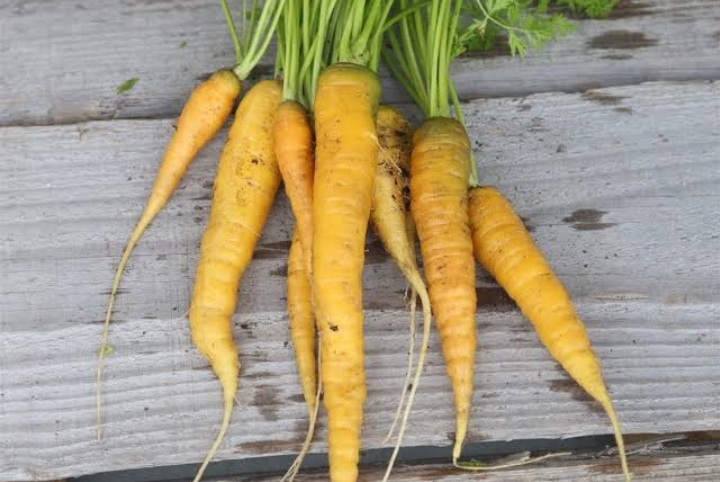
Amarillo Carrots are a unique variety of carrots cultivated in the Amarillo region of Texas since the early 1900s. They are smaller size, with bright yellow-orange color. The tops of Amarillo Carrots are often slightly hairy or fuzzy and grow about 10-15 cm above the ground. When harvested, their flavor is sweet and delicate with a light crunchy texture when eaten raw.
Characteristics
- Color: Lemon-yellow exterior
- Shape and Size: They are long and tapered, with a mature size reaching around 8 inches in length.
- Flavor: Sweet and Juicy
- Maturity: Mature in 65-70 days from planting,
Red Samurai Carrots
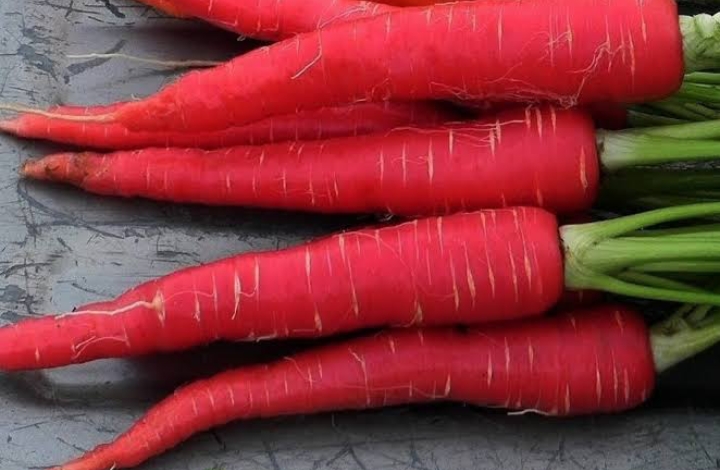
| Characteristics | Description |
|---|---|
| Color | Bright red skin with pinkish-rose flesh |
| Shape and Size | Long and tapered, reaching up to 28-35 centimeters (11″-14″) in length |
| Flavor | Sweeter than orange carrots due to larger sugary core |
| Maturity | 75 days from sowing to harvest |
Jaune Obtuse du Doubs

| Characteristics | Description |
|---|---|
| Color | Light yellow to pale yellow |
| Shape and Size | Cylindrical with an obtuse end, maturing to 15-20 centimeters (6-8 inches) in length. |
| Flavor | Milder and sweeter than orange carrots, with some gardeners reporting a subtle nutty undertone. |
| Maturity | Late variety, taking around 70 days from planting to harvest. |
Bolero Carrots
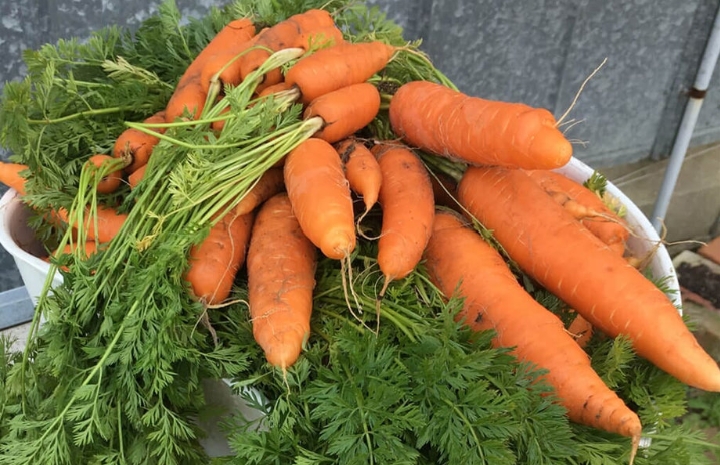
The origin of Bolero carrots is mostly unknown, but the cultivar is a type of nantes carrot, which is a grouping of carrots that were developed from a variety in the late 1850s by famous French botanist Henri Vilmorin.
Bolero carrots are thick roots having a cylindrical shape with blunt, curved ends. The skin is orange with dark green patches on the root’s shoulders. Underneath the skin, the flesh has a solid orange. Bolero carrots are crunchy with a snap-like quality and have a mild, sweet, and earthy flavor.
Characteristics
| Characteristics | Description |
|---|---|
| Color | Deep purple-black exterior with marbled purple and orange interior |
| Shape and Size | Cylindrical with a tapered tip, maturing to around 7-8 centimeters (3-4 inches) in length |
| Flavor | Sweet and earthy, with some gardeners reporting a slight bitterness that can be balanced by cooking methods or complementary flavors. |
| Maturity | Relatively fast growers, reaching maturity in around 75 days from planting. |
Napoli Carrots

They are considered an early or full-sized carrot variety, depending on harvest time. For early bunching, they are harvested at a smaller size, around 7-8 centimeters (3-4 inches) long. If left to mature fully, they can reach up to 20 centimeters (8 inches) in length.
| Characteristics | Description |
|---|---|
| Color | Dark green tops with slightly tapered dark orange roots |
| Shape and Size | Early bunching: 7-8 centimeters (3-4 inches) long, Full-sized: Up to 20 centimeters (8 inches) long |
| Flavor | Sweet when young, sweeter with maturity |
| Maturity | Early Bunching: 50-60 days, Full-Sized: 70 days |
Sugarsnax 54

The Sugarsnax 54 carrot is a hybrid variety. It is an early Imperator-type carrot with slim roots that can grow up to 10 to 12 inches in length. These carrots are a product of breeding efforts in Germany. The carrots can be harvested after about 10–12 weeks (63 days) from sowing. They have a sweet and mild flavor. They lack the strong carotene taste of some orange carrot varieties.
Autumn King
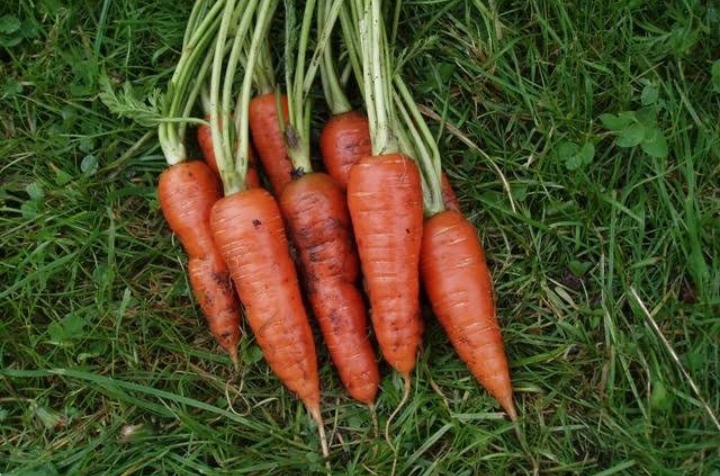
These carrots are typically sown in May/early June to harvest large roots in the Autumn for storing over winter. They can also be left in the ground and harvested overwinter in milder areas with well-drained soils, although they can be vulnerable to hungry mice in this situation.